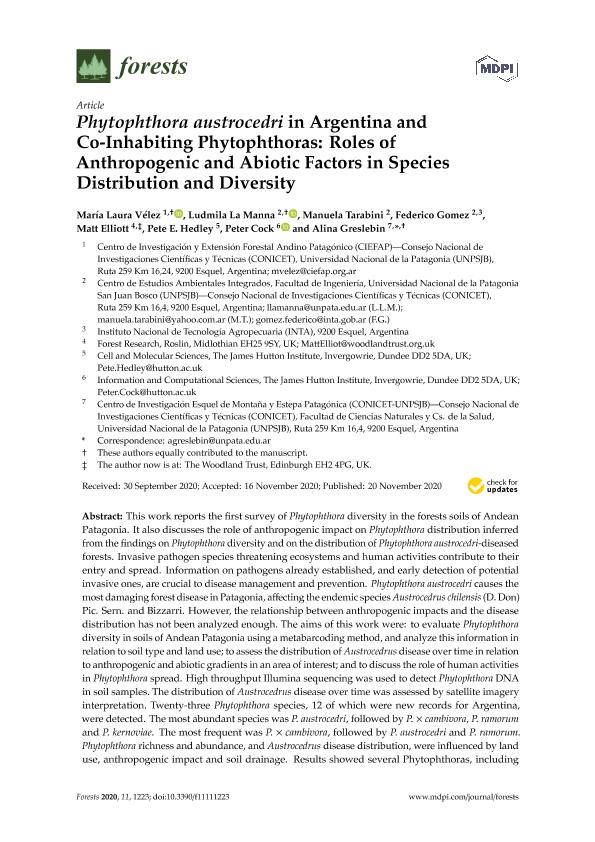Artículo
Phytophthora austrocedri in Argentina and Co-Inhabiting Phytophthoras: Roles of Anthropogenic and Abiotic Factors in Species Distribution and Diversity
Vélez, María Laura ; la Manna, Ludmila Andrea
; la Manna, Ludmila Andrea ; Tarabini, Manuela Mabel
; Tarabini, Manuela Mabel ; Gomez, Federico Antonio
; Gomez, Federico Antonio ; Elliott, Matt; Hedley, Pete E.; Cock, Peter; Greslebin, Alina Gabriela
; Elliott, Matt; Hedley, Pete E.; Cock, Peter; Greslebin, Alina Gabriela
 ; la Manna, Ludmila Andrea
; la Manna, Ludmila Andrea ; Tarabini, Manuela Mabel
; Tarabini, Manuela Mabel ; Gomez, Federico Antonio
; Gomez, Federico Antonio ; Elliott, Matt; Hedley, Pete E.; Cock, Peter; Greslebin, Alina Gabriela
; Elliott, Matt; Hedley, Pete E.; Cock, Peter; Greslebin, Alina Gabriela
Fecha de publicación:
11/2020
Editorial:
MDPI AG
Revista:
Forests
ISSN:
1999-4907
Idioma:
Inglés
Tipo de recurso:
Artículo publicado
Clasificación temática:
Resumen
This work reports the first survey of Phytophthora diversity in the forests soils of Andean Patagonia. It also discusses the role of anthropogenic impact on Phytophthora distribution inferred from the findings on Phytophthora diversity and on the distribution of Phytophthora austrocedri-diseased forests. Invasive pathogen species threatening ecosystems and human activities contribute to their entry and spread. Information on pathogens already established, and early detection of potential invasive ones, are crucial to disease management and prevention. Phytophthora austrocedri causes the most damaging forest disease in Patagonia, affecting the endemic species Austrocedrus chilensis (D. Don) Pic. Sern. and Bizzarri. However, the relationship between anthropogenic impacts and the disease distribution has not been analyzed enough. The aims of this work were: to evaluate Phytophthora diversity in soils of Andean Patagonia using a metabarcoding method, and analyze this information in relation to soil type and land use; to assess the distribution of Austrocedrus disease over time in relation to anthropogenic and abiotic gradients in an area of interest; and to discuss the role of human activities in Phytophthora spread. High throughput Illumina sequencing was used to detect Phytophthora DNA in soil samples. The distribution of Austrocedrus disease over time was assessed by satellite imagery interpretation. Twenty-three Phytophthora species, 12 of which were new records for Argentina, were detected. The most abundant species was P. austrocedri, followed by P. × cambivora, P. ramorum and P. kernoviae. The most frequent was P. × cambivora, followed by P. austrocedri and P. ramorum. Phytophthora richness and abundance, and Austrocedrus disease distribution, were influenced by land use, anthropogenic impact and soil drainage. Results showed several Phytophthoras, including well-known pathogenic species. The threat they could present to Patagonian ecosystems and their relations to human activities are discussed. This study evidenced the need of management measures to control the spread of P. austrocedri and other invasive Phytophthora species in Patagonia.
Palabras clave:
FOREST DISEASES
,
INVASIVE SPECIES
,
METABARCODING
,
RISK MODELS
Archivos asociados
Licencia
Identificadores
Colecciones
Articulos(CCT - PATAGONIA NORTE)
Articulos de CTRO.CIENTIFICO TECNOL.CONICET - PATAGONIA NORTE
Articulos de CTRO.CIENTIFICO TECNOL.CONICET - PATAGONIA NORTE
Articulos(CIEMEP)
Articulos de CENTRO DE INVESTIGACION ESQUEL DE MONTAÑA Y ESTEPA PATAGONICA
Articulos de CENTRO DE INVESTIGACION ESQUEL DE MONTAÑA Y ESTEPA PATAGONICA
Articulos(SEDE CENTRAL)
Articulos de SEDE CENTRAL
Articulos de SEDE CENTRAL
Citación
Vélez, María Laura; la Manna, Ludmila Andrea; Tarabini, Manuela Mabel; Gomez, Federico Antonio; Elliott, Matt; et al.; Phytophthora austrocedri in Argentina and Co-Inhabiting Phytophthoras: Roles of Anthropogenic and Abiotic Factors in Species Distribution and Diversity; MDPI AG; Forests; 11; 11; 11-2020; 1-24
Compartir
Altmétricas



